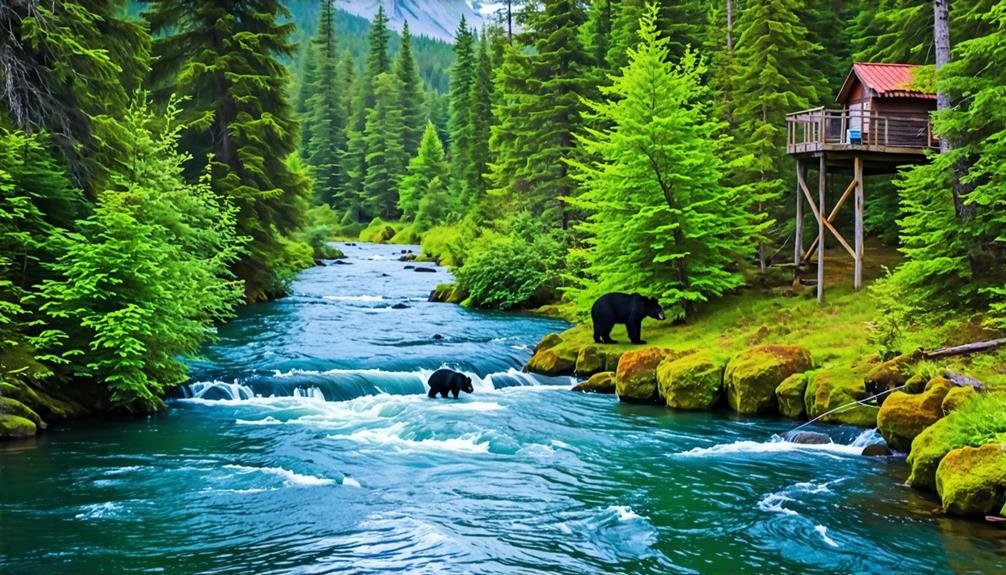Anan Wildlife Observatory, nestled in the Tongass National Forest, stands out as a prime location for safely spotting black and brown bears, especially during the salmon spawning season from July 5 to August 25. Visitors can observe bears from designated platforms built for secure viewing, which also provides an opportunity to see other wildlife such as seals and eagles. To secure a safe and enjoyable experience, it is vital to obtain permits, travel in groups, and adhere to safety guidelines set by the U.S. Forest Service. If you seek a deeper understanding of this unique experience, further insights await.
Why Anan Wildlife Observatory Is Unique
Anan Wildlife Observatory is a premier destination for bear enthusiasts. It is located within the Tongass National Forest, where Anan Creek and numerous salmon runs create an ideal environment for black and brown bears. This setting attracts bears and allows visitors to spot them from a safe distance, ensuring minimal disruption to their natural behavior.
The observatory functions as a platform, offering close observation opportunities without causing alarm to the bears. During peak salmon season, from July 5 to August 25, crowds of bears gather to feast on fish, providing an unforgettable experience for travelers in Alaska.
In addition to bear watching, Anan Wildlife Observatory presents opportunities to observe seals and eagles, enriching the wildlife experience. The blend of diverse wildlife, safety measures, and stunning natural scenery makes Anan Wildlife Observatory a unique attraction for nature lovers, promising a memorable adventure in Alaska's wilderness.
Planning Your Visit
Planning Your Visit
If you are eager to witness the incredible wildlife at the observatory, careful preparation is essential for a successful visit during the peak salmon season. This prime period for bear sightings occurs from July 5 to August 25, when both black bears and brown bears gather in large numbers at Anan Creek. To ensure safety and protect the natural habitat, a limited number of visitors are allowed each day. Therefore, obtaining permits is necessary, available through recreation.gov.
Moreover, making transportation arrangements in advance is crucial. Accessibility options include private water taxis, the Breakaway Ferry, or flights from cities such as Seattle, Juneau, and Anchorage. Hiring an authorized guide is highly advisable for securing reservations and ensuring a smooth experience.
Upon arrival, visitors will receive important safety instructions from a U.S. Forest Service ranger, promoting responsible interactions with the wildlife. As you prepare for your visit, remember that adhering to established guidelines is vital for the protection of both yourself and the bears, allowing for a rewarding and unforgettable adventure in this stunning Alaskan wilderness.
The Observing Experience

The viewing experience at the Wildlife Observatory presents guests with an extraordinary chance to observe Ursidae and other fauna in their native environment. Located within the Tongass National Forest, the observatory offers an optimal perspective to watch both black and brown bears congregate in significant numbers during the salmon spawning season, particularly from July 5 to August 25. The innovative structure of the observatory resembles a platform, facilitating close yet secure observation that does not disturb the bears.
Guests can anticipate witnessing numerous bears simultaneously, often positioned in the river to capture salmon, creating an exhilarating display. Furthermore, the observatory acts as a focal point for spotting other wildlife, such as Phoca (seals), Haliaeetus (eagles), and Mustela vison (mink), enhancing the overall experience. The sheltered areas provide excellent photography settings, enabling visitors to immortalize their adventurous encounters.
With restricted visitor access, reservations are essential, fostering a more personal and considerate connection with the environment. This meticulously regulated approach to wildlife observation ensures that guests can appreciate the splendor of Alaska's wildlife while preserving the sanctity of their habitat.
Safety Guidelines for Visitors
When visiting the Anan Wildlife Observatory, following safety guidelines is vital for both visitors and bears. A U.S. Forest Service ranger will provide essential safety instructions, ensuring that all attendees grasp bear safety protocols before proceeding. Furthermore, visitors must adhere to designated trail access protocols to minimize risks and improve the overall experience while observing these magnificent animals in their natural habitat.
Bear Safety Briefing
Visitors can ensure their safety while enjoying the remarkable experience of observing bears at Anan Wildlife Observatory. A comprehensive bear safety briefing is crucial for all attendees. Upon arrival, guests will receive guidance from a U.S. Forest Service ranger, who will emphasize the importance of understanding bear behavior and keeping a safe distance. Following these recommendations is vital for the protection of both individuals and the bears.
Participants should stay vigilant and avoid actions that may provoke a bear, such as sudden movements or loud sounds. Attempting to take selfies with bears is strongly discouraged, as it can result in dangerous encounters. The advised distance for observing bears is at least 100 yards, which allows for safe viewing while reducing stress on the wildlife.
Additionally, it is recommended to travel in groups, since bears are less inclined to approach larger crowds. Proper food storage and disposal practices are essential to prevent attracting bears to human areas. By adhering to these guidelines, visitors can fully enjoy the stunning experience of observing bears at Anan Wildlife Observatory while ensuring their safety and the well-being of these magnificent animals.
Trail Access Protocols
After the safety briefing by the U.S. Forest Service ranger, all visitors must follow specific trail access protocols to ensure a safe and enjoyable trip to the observatory. First, it is essential for everyone to stay within designated areas along the trail, which stretches about half a mile to the observatory. This rule reduces the likelihood of surprising bears and protects both wildlife and humans.
Visitors should hike in groups whenever possible since larger groups deter bear encounters. Additionally, maintaining a safe distance from any wildlife is crucial; the National Park Service strongly discourages taking selfies with bears to avoid dangerous situations.
Staying alert and listening for any announcements regarding bear activity is also important. Following these protocols not only enhances personal safety but also aids in preserving the natural ecosystem. By respecting these guidelines, visitors can enjoy the stunning experience of observing bears in their natural habitat while fostering a peaceful coexistence with these magnificent animals. Ultimately, adhering to these trail access protocols is vital for a fulfilling adventure at Anan Wildlife Observatory.
Wildlife Encounters Beyond Bears

Visitors to Anan Wildlife Observatory experience diverse wildlife encounters, including harbor seals, bald eagles, and American minks. This variety enhances the overall adventure beyond bear observation. The lush ecosystem surrounding the observatory creates a vibrant habitat for these species, inviting guests to immerse themselves in the area's natural splendor.
Harbor seals are often seen lounging on rocky shorelines or swimming gracefully in the waters, their sleek forms moving effortlessly. Observing these marine mammals in their natural setting adds richness to the wildlife experience, highlighting the interconnectedness of the ecosystem. Bald eagles, with their impressive wingspans, soar above or perch on nearby conifers, showcasing their remarkable hunting skills. Their presence symbolizes the wild spirit of nature.
Moreover, the elusive American mink may be spotted darting through the underbrush, illustrating the region's rich biodiversity. Each encounter enhances the visit, emphasizing the necessity of preserving these habitats. Ultimately, Anan Wildlife Observatory serves as a sanctuary not only for brown bears but for a multitude of wildlife, encouraging adventurers to appreciate the complexity and awe of Alaska's natural world.
Tips for a Memorable Trip
Preparation ensures a remarkable experience at Anan Wildlife Observatory, where stunning views of Alaskan bears and various animals await. Start by obtaining your permits in advance through recreation.gov, as the busy season from July 5 to August 25 attracts many nature enthusiasts. Hiring a licensed guide is advisable, as they provide transportation and valuable knowledge about the ecosystem.
Dress for the Alaskan weather; layered clothing and waterproof apparel will enhance your comfort during the adventure. Don't forget to pack binoculars and a camera to document the unforgettable sights, while respecting wildlife by keeping a safe distance. Following safety guidelines from the U.S. Forest Service is crucial for the protection of both yourself and the bears.





































